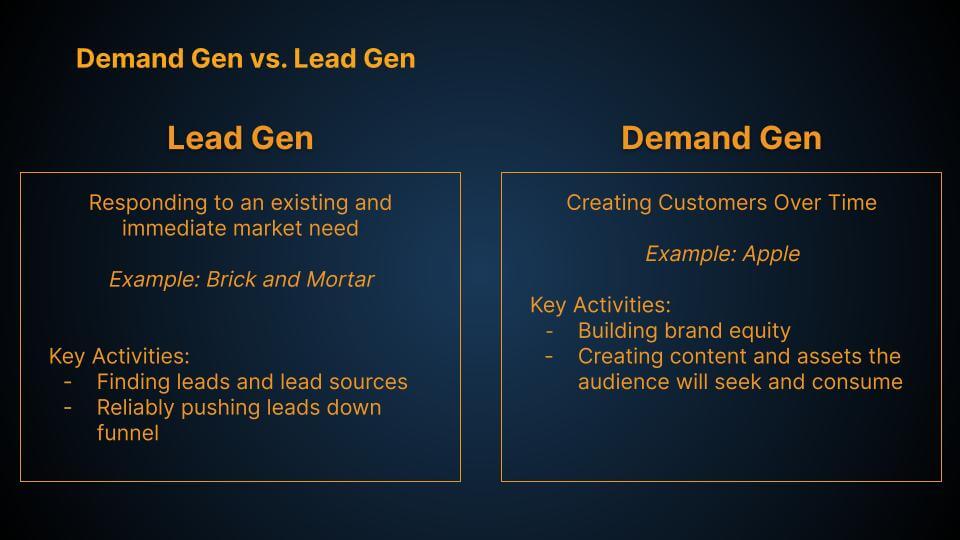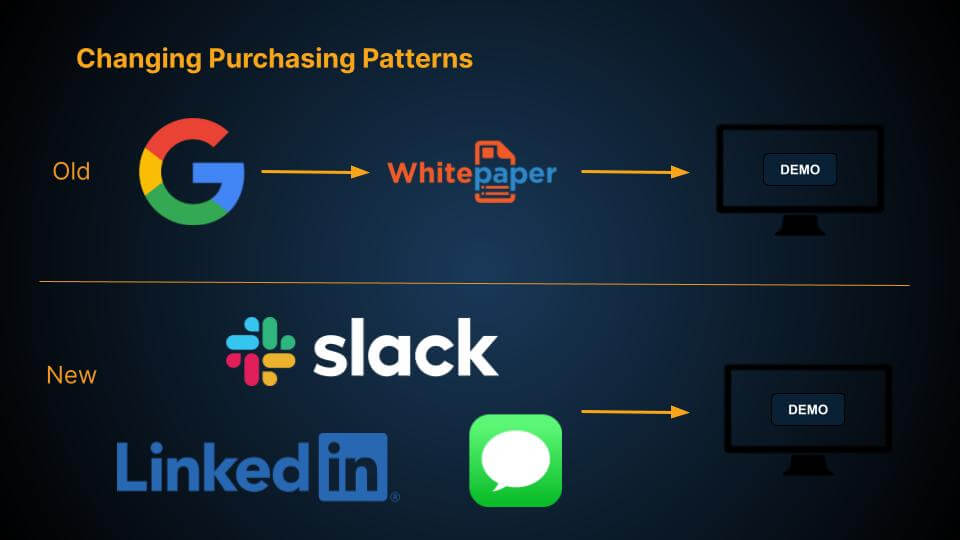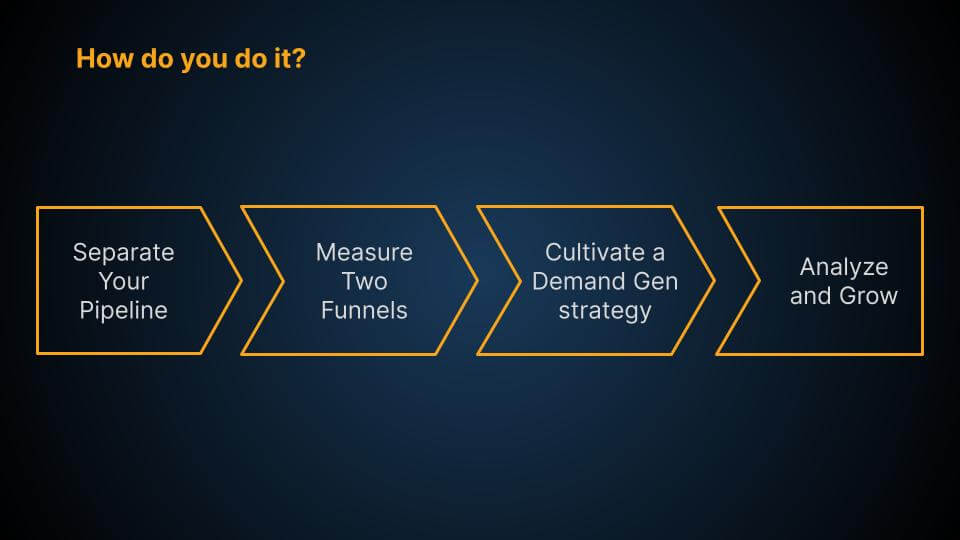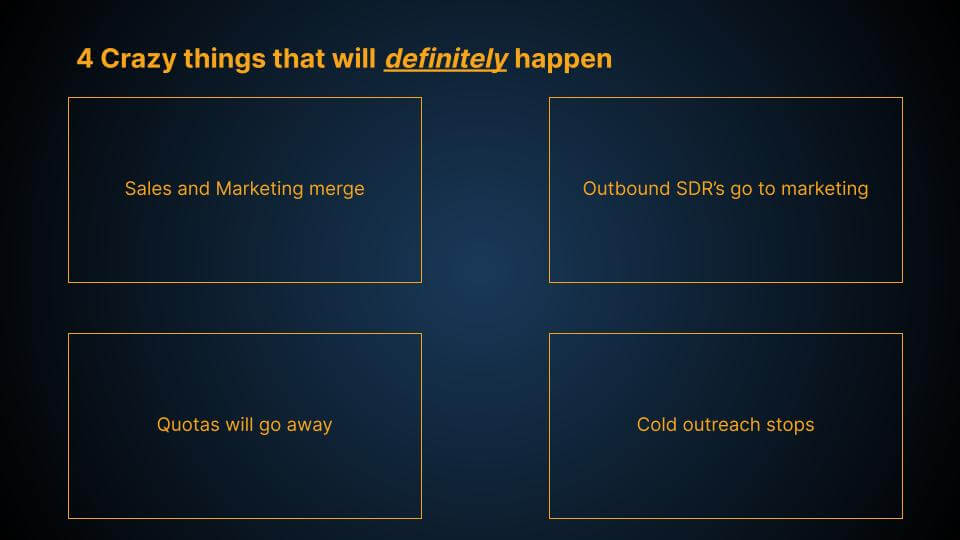Webinar Recap: Break Free of Lead Gen Shackles


How do you get off the lead gen hamster wheel?
It's 2021, and many marketers still find themselves racing to hit MQL metrics and create enough leads to satisfy sales and leadership each month. And while a lead gen strategy may work for some, in the world of the 'dark funnel' of content, a pure lead gen strategy is becoming less of a viable option for many b2b sales teams - prompting the need for a demand gen strategy to take its place. But if you want to go from lead gen to demand gen.. how do you do it? In Part 2 of their content marketing webinar series (see Part 1 here), Nick and Jason discussed how organizations moving to a demand generation marketing strategy often hit snags and can’t get away from having to generate leads. For a copy of the presentation, click here.https://youtu.be/JETTu3n-4P0
Topic: What's demand gen, anyways?
Nick and Jason discussed the differences between lead and demand gen, and when each is a good idea to pursue. The graphic below shoes a high level summary of what they arrived on:  Takeaway: While lead gen can be a viable strategy for many businesses capturing existing demand, demand gen and the creation of an audience is a far more dependable and resilient method of growth for many b2b companies
Takeaway: While lead gen can be a viable strategy for many businesses capturing existing demand, demand gen and the creation of an audience is a far more dependable and resilient method of growth for many b2b companies
Topic: Why demand gen? Why now?
While the idea of demand gen has been popular for years, Nick and Jason argue that the b2b world has recently needed to accelerate their shift from lead gen to demand gen. They explain why:  Takeaway: While older software buying cycles were straightforward and simpler, today's non-linear and 'dark' buying cycle that relies on word-of-mouth and personal referrals requires a much more nuanced demand gen strategy
Takeaway: While older software buying cycles were straightforward and simpler, today's non-linear and 'dark' buying cycle that relies on word-of-mouth and personal referrals requires a much more nuanced demand gen strategy
Topic: Moving from Lead Gen to Demand Gen
For marketers wanting to transition from lead gen to demand gen... how do they do it?  Takeaway: The road to demand gen from lead gen is far too complicated to boil down to four simplistic steps, but if we HAD to boil it down to four steps, here's how we'd do it:
Takeaway: The road to demand gen from lead gen is far too complicated to boil down to four simplistic steps, but if we HAD to boil it down to four steps, here's how we'd do it:
- Separate your pipeline. Calculate a CAC for each marketing channel, throwing out 'hand raisers' (Jason gives details on why at minute 26 in the video above). This will give you an even base to start from, and show the 'inequality' in your marketing spend in your channels
- Measure two Funnels. Change of this magnitude doesn't happen overnight. Measure your 'lead gen' funnel - that is the funnel from your typical lead gen sources, and compare to your 'demand gen' funnel of users and customers that organically find your product. Tip: The only way to really know how people found you is to ask them. So ask them!
- Cultivate a Demand Gen Strategy. Over time, shift more resources to a demand gen marketing model. Perhaps you can begin to un-gate your content, or invest more in organic ABM and away from ads - this will look different for every organization
- Analyze and Grow. Did it work? Did your overall cost of acquisition go down while revenue shot up? Set periodic goals and keep your eyes on the numbers - and be diligent! Measuring and determining success is perhaps the most important aspect of transitioning to demand gen.
Topic: Crazy predictions for the Future (that are definitely happening)
Nick and Jason ended the webinar by discussing what an industry shift towards demand gen might mean, with 4 big predictions:  Takeaway: While all four of these things are unlikely to happen, there are certainly arguments to be made for each one. For instance:
Takeaway: While all four of these things are unlikely to happen, there are certainly arguments to be made for each one. For instance:
- Sales and Marketing merge
- In a world where revenue is the only defined goal, and there is no 'neat' process from marketing lead to sale, why should they be different organizations?
- Outbound SDR's go to marketing
- Are SDR's really generating demand in sales? Or would they be. afar more cross-functional and talented value add to the organization if they 'lived' inside of marketing and were responsible for generating content and demand as well?
- Quotas go away
- Oddly enough, early adopters are already making this happen. We see this trend accelerating as revenue generation becomes more equitable and team-driven
- Cold outreach stops
- This is more wishful thinking. Cold outreach, while effective, is oftentimes the least strategic part of sales relegated to SDR's. By leaning into demand generation and away from cold outreach, we could see a shift in how the industry approached sales in marketing in general
Questions? Comments? You can find Nick and Jason on Linkedin, where they love to talk demand gen.